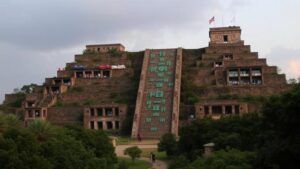Retracing the steps of treasure hunters who mysteriously vanished in tunnel systems.
Retracing the Steps of Treasure Hunters Who Mysteriously Vanished in Tunnel Systems
Throughout history, the allure of hidden treasures has lured countless adventurers into the depths of the earth, often leading to their mysterious disappearances. This article explores some notable cases of treasure hunters who vanished within intricate tunnel systems, examining the circumstances of their expeditions and the theories surrounding their fates.
The Enigma of the Lost Mine of Ophir
One of the most famous tales of treasure hunting is that of the Lost Mine of Ophir, believed to be a source of immense wealth sought by explorers since biblical times. In particular, treasure hunters in the mid-20th century, such as William Billy Williams, ventured into uncharted territories in the Sierra Nevada Mountains of California but never returned.
The Historical Context
According to historical accounts, Ophir was reputedly rich in gold and precious materials, with its exact location a subject of fervent speculation. search gained momentum in the 1840s when prospectors staked claims in the Sierra Nevada region. In 1940, the mysterious disappearance of Williams and his team, consisting of four other hunters, spurred significant interest in the mine.
The Search Efforts
When the group failed to return, local search parties were quickly mobilized. Despite extensive searches in rugged terrain, no evidence of their whereabouts was discovered. Rumors developed that the hunters had become trapped in a concealed system of tunnels associated with Ophir, possibly succumbing to hazardous conditions or accidents. Hikers and treasure seekers continue to search the area today, fueled by tales of undiscovered riches and the enigmatic fate of Williams and his team.
Recent Findings
In recent years, new technologies such as ground-penetrating radar (GPR) have been employed to scan the area. Although no remains or artifacts have been found, the search continues, albeit with caution, as many of the potential tunnel entrances are unstable.
The Disappearance at the Bimah Mine
Another intriguing case is that of the Bimah Mine in the late 1800s, located near Cripple Creek, Colorado. A group of treasure hunters led by Captain John McGowan disappeared while searching for rumored gold caches hidden in a series of tunnels beneath the mine.
The Background of Bimah Mine
Bimah Mine was notorious for treacherous conditions and cave-ins, making it a perilous site for treasure hunting. In 1887, McGowan and his crew entered the mine but never emerged. Subsequent searches yielded no results, and the case exemplifies the risks faced by treasure hunters drawn to dangerous environments.
Impact on Local Lore
The story of McGowan has become a part of Cripple Creek folklore. Many locals recount tales of ghostly sightings and strange occurrences near the mine, suggesting that the spirits of lost treasure hunters haunt its tunnels. The mine remains a popular destination for tourists eager to explore its history and experience the thrill of the chase.
Lessons from the Bimah Mine
This case serves as a critical reminder of the extreme risks involved in treasure hunting. While adventurers seek fortune, they must also respect the hazardous nature of underground environments, where poor visibility and structural instability can pose life-threatening challenges.
Modern-Day Treasure Seeking
Today, the spirit of adventure still beckons treasure hunters, albeit with more advanced technologies and safety measures. Modern explorers often utilize tools like metal detectors, drones, and 3D mapping systems to mitigate risks associated with underground excavation.
Examples of Technology in Use
- Ground-penetrating radar: Allows explorers to visualize underground structures without excavation.
- Geographic Information Systems (GIS): Helps to analyze and visualize locations of historical significance.
Contemporary Cases
While modern-day treasure seekers often venture into lesser-known tunnel systems, notable disappearances still occur. But, safety measures–such as having detailed maps and emergency protocols–are now commonplace to minimize risks.
Conclusion: The Thrill of Discovery and the Risks Still Present
The mysteries surrounding missing treasure hunters in tunnel systems highlight the fine line between adventure and peril. While historical cases like that of the Lost Mine of Ophir and Bimah Mine captivate our imaginations, they also remind us of the potential dangers involved in the search for hidden wealth.
For today’s treasure hunters, an emphasis on safety and the use of technology can significantly enhance the expedition experience. As history has shown, the thrill of discovery should always come with respect for the inherent risks of the pursuit.


